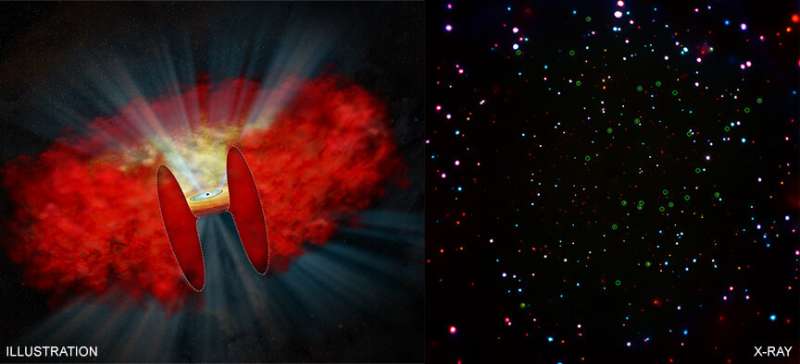Cases of black hole mistaken identity

Astronomers have discovered one type of growing supermassive black hole masquerading as another, thanks to a suite of telescopes including NASA's Chandra X-ray Observatory. The true identity of these black holes helps solve a long-running mystery in astrophysics.
The misidentified black holes are from a survey known as the Chandra Deep Field-South (CDF-S), the deepest X-ray image ever taken.
Supermassive black holes grow by pulling in surrounding material, which is heated and produces radiation at a wide range of wavelengths including X-rays. Many astronomers think this growth includes a phase, which happened billions of years ago, when a dense cocoon of dust and gas covers most black holes. These cocoons of material are the fuel source that enables the black hole to grow and generate radiation.
Based on the current picture held by astronomers many black holes immersed in such a cocoon (referred to as "heavily obscured" black holes) should exist. However, this type of growing black hole is notoriously difficult to find, and until now the observed number has fallen short of predictions—even in the deepest images like the CDF-S.
"With our new identifications we've found a bunch of heavily obscured black holes that had previously been missed," said Erini Lambrides of Johns Hopkins University (JHU) in Baltimore, Maryland, who led the study. "We like to say we found these giant black holes, but they were really there all along."
The latest study combined over 80 days of Chandra observing time in the CDF-S with large amounts of data at different wavelengths from other observatories, including NASA's Hubble Space Telescope and NASA's Spitzer Space Telescope. The team looked at black holes located 5 billion light years or more away from Earth. At these distances, scientists had already found 67 heavily obscured, growing black holes with both X-ray and infrared data in the CDF-S. In this latest study, the authors identified another 28.
These 28 supermassive black holes were previously categorized differently—either as slowly growing black holes with low density or nonexistent cocoons, or as distant galaxies.
"This could be considered a case of mistaken black hole identity," said co-author Marco Chiaberge of Space Telescope Science Institute in Baltimore, Maryland, "but these black holes are exceptionally good at hiding exactly what they are."
Lambrides and her colleagues compared their data with expectations for a typical growing black hole. Using data from all of the wavelengths except for X-rays, they predicted the amount of X-rays they should be detecting from each black hole. The researchers found a much lower level of X-rays than they expected from 28 sources, which implies that the cocoon around them is about ten times denser than scientists previously estimated for these objects.
Taking the higher density of the cocoon into consideration, the team showed that the misidentified black holes are producing more X-rays than previously thought, but the denser cocoon prevents most of these X-rays from escaping and reaching the Chandra telescope. This implies they are growing more quickly.
Previous groups did not apply the analysis technique adopted by Lambrides and her team, nor did they use the full set of data available for the CDF-S, giving them little information about the density of the cocoons.
These results are important for theoretical models estimating the number of black holes in the universe and their growth rates, including those with different amounts of obscuration (in other words, how dense their cocoons are). Scientists design these models to explain a uniform glow in X-rays across the sky called the "X-ray background," first discovered in the 1960s. Individual growing black holes observed in images like the CDF-S account for most of the X-ray background.
The X-ray background not currently resolved into individual sources is dominated by X-rays with energies above the threshold that Chandra can detect. Heavily obscured black holes are a natural explanation for this unresolved component because lower-energy X-rays are absorbed by the cocoon more than high-energy ones, and therefore are less detectable. The additional heavily obscured black holes reported here help reconcile past differences between the theoretical models and observations.
"It's like the X-ray background is a blurry picture that has been slowly coming into focus for decades," said co-author Roberto Gilli from the National Institute of Astrophysics (INAF) in Bologna, Italy. "Our work has involved understanding the nature of the objects that have been some of the last to be resolved."
In addition to helping explain the X-ray background, these results are important for understanding the evolution of supermassive black holes and their host galaxies. The masses of galaxies and their supermassive black holes are correlated with each other, meaning that the more massive the galaxy the more massive the black hole.
A paper reporting the results of this study is being published in The Astrophysical Journal. The other authors of the paper are Timothy Heckman of JHU; Fabio Vito from Pontificia Universidad Católica de Chile, in Santiago, Chile; and Colin Norman from JHU.
NASA's Marshall Space Flight Center manages the Chandra program. The Smithsonian Astrophysical Observatory's Chandra X-ray Center controls science and flight operations from Cambridge and Burlington, Massachusetts.
More information: A Large Population of Obscured AGN in Disguise as Low Luminosity AGN in Chandra Deep Field South, arxiv.org/abs/2002.00955
Journal information: Astrophysical Journal
Provided by Chandra X-ray Center



















